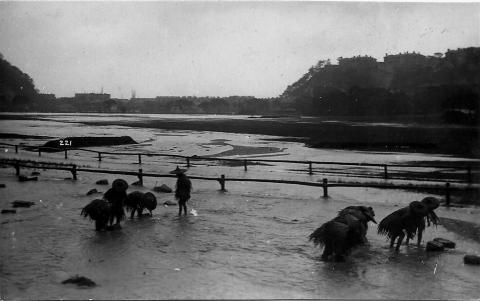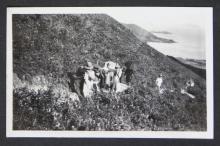Happy Valley
Primary tabs
From Kennedy Road we moved to Happy Valley. It was our home for some years, and the part of Hong Kong most closely associated with our childhood. We lived in one of a long terrace of houses in Wong Nei Chong Road, and at the seaward end of the road we caught the tram to school. The trams were double-decked. The upper deck and a small section of seats behind the driver were the 1st Class; and the 2nd Class was the rest of the lower deck, with its own door at the back.
One of my early memories of the trams was of seeing Harold Chaney and Ettie Stainfield sitting downstairs holding hands. They later married and had a daughter Yvonne. Then tragically Harold was killed while riding his motor cycle. Ettie changed her name to Claire. She was a vivacious amusing person with a succession of boy friends, and became one of Mamma's best friends.
My Chinese school friend Ruby Chue and her younger sister Lily lived next door to us in Wong Nei Chong Road. On special occasions, a birthday or a wedding or Chinese New Year, they invited me to their house to eat Chinese cakes and sweets, and to be present at the great ceremony of firing off a giant string of crackers. They were of all sizes, wrapped in red paper - the colour of good luck and happiness - and tied together in tens and hundreds to make a long wide string which was hung from the roof of the house down to the ground. The giant string of fire-crackers was lit at the bottom, and began banging away, the explosions gradually coming nearer and nearer to us as we stood on the first floor verandah, with the middle of the string hanging perilously close to us! Extra large crackers had been fastened at intervals, so that it was "bang, bang, bang, bang" - then "BANG, BANG"- deafening noise and smoke, and acrid smell. We held our breath as the explosions passed us on their way up, and the loudest bangs of all came at the top of the string. The air was full of smoke and the wonderful smell of crackers, and every one could talk again.
In those days there was often the sound of fire crackers, usually only single ones or small strings; and then occasionally these giant strings. Another sound frequently heard was the blasting of rock, to make room for a new building.
At the other end of our terrace lived an Irish family, the Tollans. The girls were Lizzie, Annie, Rose, Lorna and Chrissie. Perhaps it was at this time that we began to play the Irish games, "O Grady says", "Surrender to the King of the Baltimore", and the skipping rope game "One, two, three, O Leary"! We also played the Chinese game of Stone, Paper, Scissors, Stone, "Stone break scissors, scissors cut paper, paper cover stone"; and the game of Five Stones.
Audrey was always out playing with the other children, but I liked to lie on the sofa reading. I was fascinated by Angela Brazil's stories of school girls in England.
About this time William Crocker came into our lives, a handsome black haired man in the Navy. With his lively, cheerful manner and sense of fun, he radiated happiness and laughter. He and Mamma shared a love for music, especially Italian Opera, and from then on our gramaphone played nothing but "Rigoletto" and "La Traviata", and the voices of Caruso, Galli-Curci and Tetrazini became familiar in our house. Whenever a visiting Italian Opera Company played in Hong Kong Mamma and "Crocks" would attend every performance. She loved the Jewel Song from "Faust", but Audrey and I preferred the Storm and the Calm from "William Tell". I am sure Mamma would have married Crocks, but sadly he had a wife and two daughters at Home in Devon. Audrey was jealous of him but I would have been happy to acquire a father.
Mamma joined the Craigengower Club and played tennis again. It was one of the Sports Clubs of Happy Valley beside the Race Course. The Leach family lived near us in Wong Nei Chong Road. The father Robert Leach had come from Malaya, a dark large man with a brown skin, very kind and generous. The mother Alice Lefevre Leach was very thin, dark haired and dark eyed, with some French blood, artistic and romantic and fond of children. Their family were Rob, Jim and Dick, and Daphne. Jim was fair haired and blue eyed, the others were all dark, Dick very like his father. We became friends with this family, and spent a lot of time with them, playing on the race course near the Black Rock. On one never to be forgotten occasion it poured with rain for days, and the whole Valley was flooded. We took off our shoes and socks and paddled, enjoying the sensation of bare feet on soaked grass.
Many were the happy hours we spent gathered round Mrs. Leach at the piano, singing while she played songs from the song books piled up by the piano. Two of our favourites were:-
"There was a maid Hang Hang, She lived by the shores of the Yang tse-kiang"
and
"Once a little geisha called Wee San, Pretty as a picture on a fan"!
We all attended the Wesleyan Methodist Sunday School, on the other side of the Valley beyond the Monument at the beginning of Wanchai, where we sang hymns, and were taught Bible stories and given pretty Biblical text cards to keep. "Tell me the stories of Jesus, I long to hear", "Jesus bids us shine with a pure clear light", and "Jesus wants me for a sunbeam" were three of our hymns.
Wong Nei Chong Road was lined with Bauhinia trees, lovely with their deep pink flowers and unusual two-lobed leaves. Rose apple trees grew there as well; their greeny-white flowers turned into a scented fruit. Lantana bushes grew wild. They had a horrible smell, but we used to thread the little orange, pink and white flowers on to grass chains. Other wild flowers were pink oxalis, whose sour leaves you could eat; a verbena, snakeweed, with tiny blue flowers growing on a stiff spike, and the sensitive plant, mimosa pudica,with fluffy pink flowers and leaflets that magically began moving and closing up when you touched them.
The Leaches had a house full of animals, a dog called Caesar and several cats, one named the Lord Mayor of Cork, because it would not eat its food. The children called it "The Lord".
Mr. Leach was a Sea Captain, and used to bring back exotic foods from other ports. One of them was a syrupy drink called Grenadine.
At this time the Girl Guide Movement began in Hong Kong. Mrs. Porri, the energetic wife of the Methodist Church parson, the Reverend Clouston Porri, organised the first Troop to be raised in the Colony - ours. The Porris lived on Morrison Hill (demolished in later years) and our meetings were held in their garden, or if it rained in their house. We were known as the 1st Wanchai Girl Guides.
Mrs. Porri was Captain. I joined with school friends Nancy McEwen, Marjorie Hansen, Ruby Chue and Daphne Nicol among others. We learned first aid, bandaging; and to drill, to track, to signal by morse and semaphore, to tie sailors' knots, and many other new and unusual things. We were immensely proud of our blue uniforms, and our hats, stripes, badges and Girl Guide belts. I was Leader of the Forgetmenot Patrol, a strange flower to choose in a land where there were no forgetmenots! Audrey, Daphne Leach, Kathleen McEwen and Zena Bersey were Brownies.
We used to see grand Chinese processions going through the streets. Sometimes it was a wedding, the bride being carried to her new home in a sedan chair. She was completely hidden from the public gaze by curtains. With her in the procession were musicians, playing loud cheerful music; and servants carrying all her possessions, including tables, chairs, cupboards, wardrobes and all kinds of things to her new home.



Comments
Photo of Flooding in Happy Valley
May I ask what those people wearing straw raincoats are supposed to be doing in the picture? Clearing the drains?Anyone would think they were water buffalo.
Looks like Leighton Hill on the distant right and Morrison Hill on the left.
Photo of flooding in Happy Valley
When was Morrison Hill pulled down? There is another photo I've posted in the diary which shows rubble, so clearly after this one. I have no idea what the people are actually doing, unless it is what you suggest.
Morrison Hill was pulled down
Morrison Hill was pulled down over several decades, but work started in the 1920s and most of it was gone by the end of the deecade. Here's a 1924 photo that looks to be later than Betty's photo above:
http://gwulo.com/node/19775
Regards, David
Harold Chaney
Mention is made of Harold Chaney in the HK Telegraph dated 13 December 1924 There is a photo of him on his motorcyle.